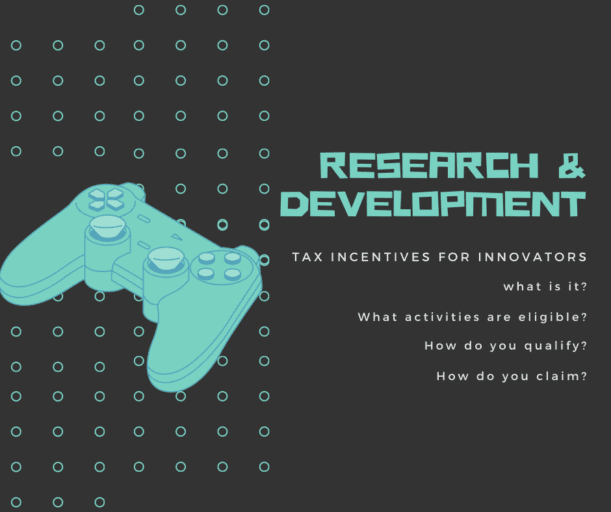What is a Research and Development tax incentive?
Do you have a great idea and need support to commercialise it? Would a Research & Development (R&D) Tax Incentive help?
As an incentive to encourage Australian business to engage in R&D activities benefiting Australia, the R&D tax incentive was created. The incentive has two core components you may be eligible for if you engage in R&D activities:
- A 43.5% refundable tax offset for businesses with an aggregated turnover of less than $20m p.a.
- A 38.5% non-refundable tax offset for all other eligible entities
The purpose of the Research and Development tax incentive is to increase competitiveness and improve productivity across the Australian economy. This involves:
- Encouraging industry to conduct R&D in all areas, including areas it may not have been in other circumstances.
- Improving the incentive for smaller firms to undertake R&D
- Providing business with more predictable, less complex support
The ATO and the Department of Industry, Innovation and Science (on behalf of Innovation and Science Australia) jointly administer the Research and Development tax incentive. You must register your R&D activities before you can claim on them. Registration is with the Department of Industry, Innovation and Science.
How to I qualify for a Research and Development tax incentive?
You must be an R&D entity and have incurred notional deductions of at least $20,000 on eligible Research & Development activities during the year.
- Eligible entities – You need to be an incorporated entity in Australia. Individuals, partnerships, and trusts will not qualify for the incentive.
- Eligible activities – You must be conducting the R&D activity in Australia. However, special conditions do exist for overseas activities to qualify. If you are eligible for the incentive, the activities must classify as either:
-
- Core R&D activities – These are experimental activities whose outcome is unknown or undetermined in advance. They must be based on current knowledge, information or experience. You would also need to be using established scientific principles need to determine the outcomes. These include hypothesis to experiment, observation and evaluation, and lead to logical conclusions. Conducting these tests must be for the purpose of generating new knowledge.
- Supporting R&D activities – These relate directly to supporting the implementation of core Research and Development activities.
- Eligible deductions – If you’re a research and development entity, you may be able to claim a notional deduction for expenditure incurred directly on R&D activities. This includes amounts paid to associates and expenditure on a Research Service Provider. Also included is:
- Depreciation on asset
- Costs associated to goods and
- Materials transformed or processed during research and development activities.
The following items are specifically ineligible for the R&D incentive:
- Interest,
- Expenditure, which is not at risk,
- Purchase of core technology, and
- Costs incurred to construct or acquire a building.

How to claim a research and development tax incentive?
If you believe you’re a Research and Development entity, you will need to register with the Department of Industry, Innovation and Science. You need to complete this registration for every tax year you wish to claim the offset. You must also do this before lodging your company’s tax return, and within 10 months of the financial year-end. Follow this link to complete the registration process: Research and Development Tax Incentive
The Research and Development tax incentive is a self-assessment program. This means you will determine if your R&D activities are eligible for the incentive before you apply to register for the program. Due to the complex and varied nature of any Research and Development activity, we suggest your seek specialist advice from your tax professional. Also, you must keep appropriate records, as substantiation rules apply, as they do across all tax records.
Recent changes to the research and development tax incentive
2020 Budget
Legislation passed in October 2020 removed the Research and Development tax incentive refund cap for companies with a turnover less than $20 million. This was previously capped at $4 million. For larger entities, it also permanently increased the R&D expenditure threshold. This went from $100 million to $150 million. Furthermore, the Research & Development tax offset was linked to the claimant’s corporate tax rate plus an 18.5% premium.
Select committee on Financial Technology and Regulatory Technology
Last month, this committee, chaired by Senator Andrew Bragg, released its second interim report on how the Federal Government could improve its support of Research and Development activities in Australia. Industry leaders explained how important the Research and Development tax incentive is in supporting innovation in Australia. They also noted, despite recent guidance provided, the incentive in its current form is not suitable for software development.
The committee handed down 23 recommendations. The key recommendations in relation to the research and development tax incentive include:
- Amendments to the incentive allowing for:
- Using different assessment methodologies; and
- Quarterly payments to successful applicants.
- The Australian Government considered the establishment of a separate software-specific tax incentive scheme.
- Abolish non-resident interest withholding tax to enable further access to competitive offshore funding.
Breaking News 2021-2022 Budget for Research and Development
17% Patent Box Rate
The Treasurer announced in the federal budget at the beginning of May, a “patent box tax regime”. The purpose of this is to encourage innovation in Australia by taxing companies’ income derived directly from specific types a patents, at a concessional tax rate of 17%. The current company tax rate is 30%, and soon to be 25% for small to medium-sized businesses.
This concession will initially apply to income derived from Australian medical and biotechnology patents only. It will commence from income years starting on or after 1 July 2022. It also only applies to patents applied for after budget night (11 May 2021).
By providing this incentive, the Government believes it can create an environment which will deliver long-term benefits to boost innovation in Australia. Furthermore, it will ensure ownership of these innovations remains inside of Australia.
The patent box regime builds on the JobMaker Research and Development Tax Incentive announced in the 2020-21 budget.
Digital Games Tax Offset
Introduction of a 30% digital games tax offset to promote the digital games industry in Australia. This will be a refundable tax offset for a minimum investment of $500,000 from 1 July 2022, in qualifying Australian games expenditure. Industry consultation will assist with qualifying expenditure, but will specifically exclude games with gambling elements.



